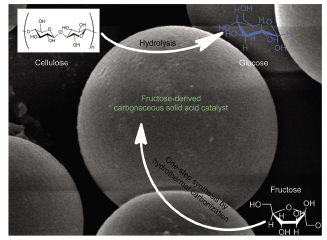| [1] Yabushita, M.; Kobayashi, H.; Fukuoka, A. Appl. Catal. B-Environ. 2014, 145, 1[2] Huber, G. W.; Iborra, S.; Corma, A. Chem. Rev. 2006, 106, 4044.[3] Sun, X. F.; Wang, H. H.; Hu, Y. H. Chem. J. Chin. Univ. 2010, 31(9), 1901. (孙晓锋, 王海洪, 胡永红, 高等学校化学学报, 2010, 31(9), 1901.) [4] Li, Q. J.; Yin, Y. l.; Su, R. X.; Qi, W.; He, Z. M. Acta Chim. Sinica 2009, 67, 88. (李秋瑾, 殷友利, 苏荣欣, 齐崴, 何志敏, 化学学报, 2009, 67, 88).[5] Zhao, Y.; Lu, W. J.; Chen, J. J.; Zhang, Y. F.; Wang, H. T. Front. Environ. Sci. Eng. 2014, 8, 151.[6] Zhao, Y.; Li D.; Lu, W. J.; Wang, H. T.; Piao, X. S. Acta Chim. Sinica 2008, 66, 2295. (赵岩, 李冬, 陆文静, 王洪涛, 朴雪松, 化学学报, 2008, 66, 2295.) [7] Lai, D. M.; Deng, L.; Guo, Q. X.; Fu, Y. Energy Environ. Sci. 2011, 4, 3552.[8] Gliozzi, G.; Innorta, A.; Mancini, A.; Bortolo, R.; Perego, C.; Ricci, M.; Cavani, F. Appl. Catal. B-Environ. 2014, 145(SI), 24.[9] Tan, I. S.; Lam, M. K.; Lee, K. T. Carbohydr. Polym. 2013, 94, 561.[10] Kobayashi, K.; Kimura, S.; Kim, U. J.; Tokuyasu, K.; Wada, M. Cellulose 2012, 19, 967.[11] Sun, Z.; Cheng, M. X.; Li, H. X.; Shi, T.; Yuan, M. J.; Wang, X. H.; Jiang, J. X. RSC Adv. 2012, 2, 9058.[12] Wang, H. Y.; Zhang, C. B.; He, H.; Wang, L. Acta Phys. Chim. Sin. 2010, 26, 1873. (王华瑜, 张长斌, 贺泓, 王莲, 物理化学学报, 2010, 26, 1873.) [13] Guo, H. X.; Qi, X. H.; Li, L. Y.; Smith, R. L. Bioresour. Technol. 2012, 116, 355.[14] Zhang, C. B.; Wang, H. Y.; Liu, F. D.; Wang, L.; He, H. Cellulose 2013, 20, 127.[15] Titirici, M. M.; White, R. J.; Falco, C.; Sevilla, M. Energy Environ. Sci. 2012, 5, 6796.[16] Ryu, J.; Suh, Y. W.; Suh, D. J.; Ahn, D. J. Carbon 2010, 48, 1990.[17] Li, X. T.; Jiang, Y. J.; Shuai, L.; Wang, L. L.; Meng, L. Q.; Mu, X. D. J. Mater. Chem. 2012, 22, 1283.[18] Van de Vyver, S.; Thomas, J.; Geboers, J.; Keyzer, S.; Smet, M.; Dehaen, W.; Jacobs, P. A.; Sels, B. F. Energy Environ. Sci. 2011, 4, 3601.[19] Fukuhara, K.; Nakajima, K.; Kitano, M.; Kato, H.; Hayashi, S.; Hara, M. ChemSusChem 2011, 4, 778.[20] Niranjane, A. P.; Madhou, P.; Stevenson, T. W. Enzyme Microb. Technol. 2007, 40, 1464.[21] Kitano, M.; Yamaguchi, D.; Suganuma, S.; Nakajima, K.; Kato, H.; Hayashi, S.; Hara, M. Langmuir 2009, 25, 5068.[22] Suganuma, S.; Nakajima, K.; Kitano, M.; Yamaguchi, D.; Kato, H.; Hayashi, S.; Hara, M. Solid State Sci. 2010, 12(6SI), 1029.[23] Huang, Y. B.; Fu, Y. Green Chem. 2013, 15, 1095.[24] Li, C. Z.; Zhao, Z. Adv. Synth. Catal. 2007, 349, 1847.[25] Qi, X. H.; Watanabe, M.; Aida, T. M.; Smith, R. L. Catal. Commun. 2009, 10, 1771.[26] Okamura, M.; Takagaki, A.; Toda, M.; Kondo, J. N.; Domen, K.; Tatsumi, T.; Hara, M.; Hayashi, S. Chem. Mater. 2006, 18, 3039.[27] Telke, A. A.; Ghatge, S. S.; Kang, S. H.; Thangapandian, S.; Lee, K. W.; Shin, H. D.; Um, Y.; Kim, S. W. Bioresour. Technol. 2012, 112, 10.[28] Wang, P.; Yu, H. B.; Zhan, S. H.; Wang, S. Q. Bioresour. Technol. 2011, 102, 4179.[29] Wang, D.; Shang, S. B.; Song, Z. Q.; Lee, M. K. J. Ind. Eng. Chem. 2010, 16, 152.[30] Yamaguchi, D.; Suganuma, S.; Nakajima, K.; Kato, H.; Hara, M. J. Phys. Chem. C 2009, 113, 3181[31] Guo, H. X.; Lian, Y. F.; Yan, L. L.; Qi, X. H.; Smith, R. L. Green Chem. 2013, 15, 2167.Sun, N.; Liu, H. B.; Sathitsuksanoh, N.; Stavila, V.; Sawant, M.; Bonito, A.; Tran, K.; Geroge, A.; Sale, K.; Singh, S.; Simmons, B. A.; Holmes, B. M. Biotechnol. Biofuels 2013, 6, 39. |
